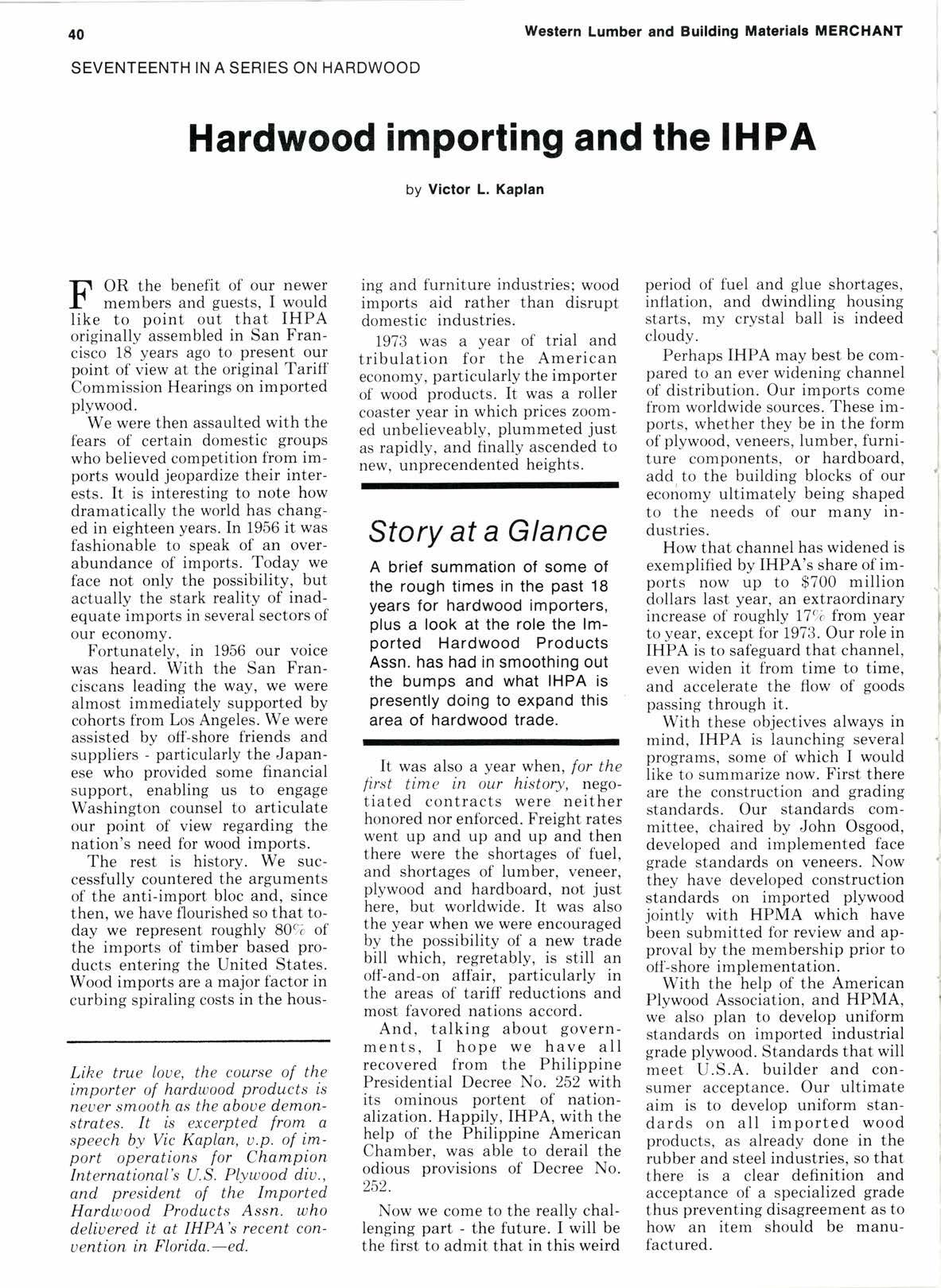
3 minute read
Hardwood importing and the IHPA
by Victor L. Kaplan
TI OR the benefit of our newer .tt members and guests, I would Iike to point out that IHPA originally assembled in San Francisco 18 years ago to present our point of view at the original Tariff Commission Hearings on imported plywood.
We were then assaulted with the fears of certain domestic groups who believed competition from imports would jeopardize their interests. It is interesting to note how dramatically the world has changed in eighteen years. In 1956 it was fashionable to speak of an overabundance of imports. Today we face not only the possibility, but actually the stark reality of inadequate imports in several sectors of our economy,
Fortunately, in 1956 our voice was heard. With the San Franciscans leading the way, we were almost immediately supported by cohorts from Los Angeles. We were assisted by off-shore friends and suppliers - particularly the Japanese who provided some financial support, enabling us to engage Washington counsel to articulate our point of view regarding the nation's need for wood imports.
The rest is history. We successfully countered the arguments of the anti-import bloc and, since then, we have flourished so that today we represent roughly 80% of the imports of timber based products entering the United States. Wood imports are a major factor in curbing spiraling costs in the hous- ing and furniture industries; wood imports aid rather than disrupt domestic industries.
Like true loue, the course of the importer of hardwood products is neuer smooth as the aboue demonstrates. It is excerpted from a speech by Vic Kaplan, u.p. of import operations f or Champion International's U. S. Plywood diu., and president of the Imported Hardwood Products Assn. who deliuered it at IHPA's recent conuention in Florida.-ed.
1973 was a year of trial and tribulation for the American economy, particularly the importer of wood products. It was a roller coaster year in which prices zoomed unbelieveably, plummeted just as rapidly, and finally ascended to new, unprecendented heights.
Story at a Glance
A brief summation of some of the rough times in the past 18 years for hardwood importers, plus a look at the role the lmported Hardwood Products Assn. has had in smoothing out the bumps and what IHPA is presently doing to expand this area of hardwood trade.
It was also a year when, for the first time in our history, nego- tiated contracts were neither honored nor enforced. Freight rates went up and up and up and then there were the shortages of fuel, and shortages of lumber, veneer, plywood and hardboard, not just here, but worldwide. It was also the year when we were encouraged by the possibility of a new trade bill which, regretably, is still an off-and-on affair, particularly in the areas of tariff reductions and most favored nations accord.
And, talking about governments, I hope we have all recovered from the Philippine Presidential Decree No. 252 with its ominous portent of nationalization. Happily, IHPA, with the help of the Philippine American Chamber, was able to derail the odious provisions of Decree No. 252.
Now we come to the really challenging part - the future. I will be the first to admit that in this weird period of fuel inflation, and and glue shortages, dwindling housing starts, my crystal ball is indeed cloudy.
Perhaps IHPA may best be compared to an ever widening channel of distribution. Our imports come from worldwide sources. These imports, whether they be in the form of plywood, veneers, lumber, furniture components, or hardboard, add. to the building blocks of our economy ultimately being shaped to the needs of our many industries.
How that channel has widened is exemplified by IHPA's share of imports now up to $700 million dollars last year, an extraordinary increase of roughly l7orc from year to year, except for 1973. Our role in IHPA is to safeguard that channel, even widen it from time to time, and accelerate the flow of goods passing through it.
With these objectives always in mind, IHPA is launching several programs, some of which I would like to summarize now. First there are the construction and grading standards. Our standards committee, chaired by John Osgood, developed and implemented face grade standards on veneers. Now they have developed construction standards on imported plywood jointly with HPMA which have been submitted for review and approval by the membership prior to ofl-shore implementation.
With the help of the American Plywood Association, and HPMA, we also plan to develop uniform standards on imported industrial grade plywood. Standards that will meet U.S.A. builder and consumer acceptance. Our ultimate aim is to develop uniform standards on all imported wood products, as already done in the rubber and steel industries, so that there is a clear definition and acceptance of a specialized grade thus preventing disagreement as to how an item should be manufactured.










